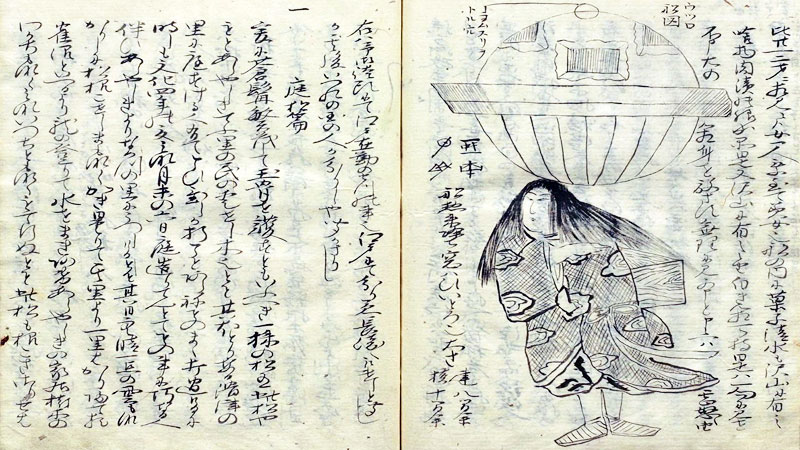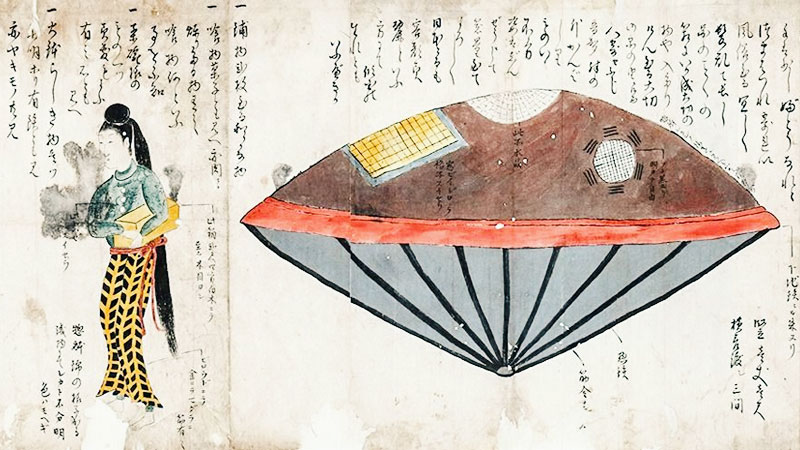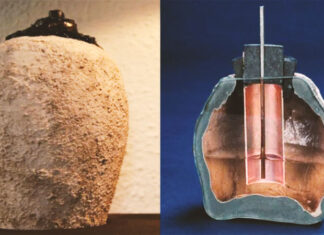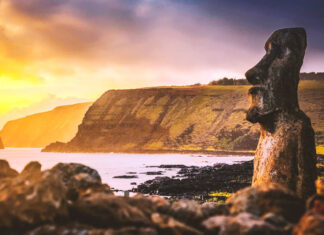UFOs became a modern sensation after Kenneth Arnold’s accounts of the flying saucers he witnessed on June 24, 1947. A month later, in July 1947, the most famous UFO event today, the fall of an alien ship in Roswell, New Mexico, took place.
However, more than a century earlier, Japan documented records of mysterious apparitions throughout the country, and the most famous, intriguing and well-documented of them is the Utsurobune Legend.
In 1803, a group of fishermen from Hitachi Province were intrigued by a mysterious round ship that reached the coast of Japan, looked like a wood boat described as nearly 6 meters wide and 4 meters high, richly decorated and adorned with bronze plates in its lower half and had several transparent windows in its upper half and such a thing would have been highly unusual in their eyes.
Peering through the windows, the fishermen saw that the walls were covered with strange texts written in an unknown language. It contained food, clothing and a beautiful young woman, with very pale skin and surprisingly red hair, wearing elegant and fluttering clothes of unknown origin and speaking an incomprehensible language, so that the fishermen could not communicate with her, but despite this, she remained friendly and courteous. She carried with her a mysterious box that protected the fishermen, no wonder how insistently they inquired about its contents.
This is the story of the “Utsurobune”, the “Hollow Ship” of Hitachi Province, found in many records of the Edo Period, dating back to the years 1603 until 1868.
Many oral traditions about “hollow ships” are found throughout Japan during this time, and several documents describe the 1803 incident and include illustrations of a beautiful woman and her strange box.

One of the best-known sources is the Toen Shosetsu, the Stories of Toen, a collection from 1825 that records fantastic stories and was written by the Toenkai literary circle. Other accounts are found in Ume No Chiri, the Plum Powder, written by Nagahashi Matajiro in 1844, and in other collections such as Oshuku Zakki, the Notes of Oshuku, Hirokata Zuihitsu, the Hirokata Essays, and Hyoryuki-shu, the Shipwreck Registry.
In total, there are at least 11 documents related to Hitachi’s stories about the Utsurobune, of which the most interesting are those of 1803, the same year that the mysterious vessel would have arrived off the coast of Japan.
Myth or Fact?
Folklorist Yanagita Kunio once said that all utsurobune legends were unfounded fictions, but in Hitachi’s case there is a clear difference between the other legends and myths of the country. The event is recorded in all documents as having occurred on a specific date, the year 1803, and in a specific location, hitachi province (now called Ibaraki), as opposed to myths that diverge or do not specify dates and locations of its occurrence.
Another fact is that there are numerous similar engravings of the ship, showing that it closely resembles a flying saucer and probably the story describes something that actually happened.
At that time Japan was closed to foreigners. After a brief period of contact with 16th century European navigators, the Japanese decided to isolate themselves from the rest of the world in order to preserve their culture, so if there had been a shipwreck or foreign people had arrived in the country, it would have been a major event and a government official would have necessarily investigated and left a public document. When British sailors arrived in Otsuhama in 1824, the event became one of the causes of the publication of a decree to repel foreign ships.
Reports of a Ninja
One of the most important descriptions can be found in the Banke Bunsho, the Banke Document, owned by Kawakami Jin’ichi, the heir to the koka ninjutsu tradition, researcher and martial artist. It was named after the Banke, or Ban family, from the ninja Koka.
This document records the location of what happened as Hitachihara Sharihama (Hitachi), a real location that appears on the map produced by the famous cartographer Ino Tadataka, and suggests that a banke member may have gathered information while working for the head of the Owari domain. “In this case, he would not register any untruth, so we can say that the document is very reliable,” says researcher Tanaka Kazuo.

Another record is found in the Bunsho Mito, the Mito Document, owned by a collector in the city of Mito in present-day Ibaraki Province. In it, researcher Tanaka realized that the woman’s clothes in an illustration of the work were similar to those of a statue of Bodhisattva at Shofukuji Temple, also in Ibaraki, which is dedicated to silkworm breeding.
A legend credits the beginning of sericulture in the region to Princess Konjiki, the “Golden Princess”, who is the subject of images in the temple. In one version of the story, Princess Konjiki is taken to the Japanese coast after traveling on a cocoon-shaped boat. She reciprocates the kindness of a local couple, who tries to take care of their health by giving them the secrets of sericulture, when she herself becomes a silkworm after her death. Among the various materials, only the illustration of the Mito Document looked very similar to that of Princess Konjiki.
Although the descriptions of the woman’s clothes vary slightly according to the documents and the same occurring with the shape and size of her vessel, Tanaka states: “They are all related to an incident that actually happened. This suggests that the writers at least believed that Utsurobune actually appeared off the coast of Japan.”
The Shipwreck Edifs Register, Hyoryuki-Shu, describes the woman as “between 18 and 20 years old, well dressed and beautiful. His face is pale and his eyebrows and hair are red. It’s impossible to communicate with her, so it’s not clear where she is from. She holds a simple wooden box as if it were something very important to her and keeps her distance. There are mysterious inscriptions on the boat.”
Close Encounters?
Much of the UFO theory about this story comes from the associated drawings and symbols that were recorded in the mentioned books. It was suggested, based on drawings of the ship, that it could have been an USO (Unidentified Submerged Object), and it was claimed that the woman’s appearance and strange costumes could be explained as those of an alien. Others claim that there is a similarity between the unidentified symbols that adorned the interior of the ship and those that were observed on the ship’s hull reported in the Rendlesham Forest Incident in England in 1980.
Among the numerous mysteries related to the “hollow ship”, the meaning of the enigmatic inscriptions may never be unraveled. Tanaka says that one theory mentions that the inscriptions resemble the pseudo-Roman letters often seen on the edge of ukiyo-e engravings, a type of woodcut and painting that thrived in Japan between the 17th and 19th centuries: “Therefore, it can be simply decorative. Although it is not impossible to uncover evidence of an alien inscription!”

















